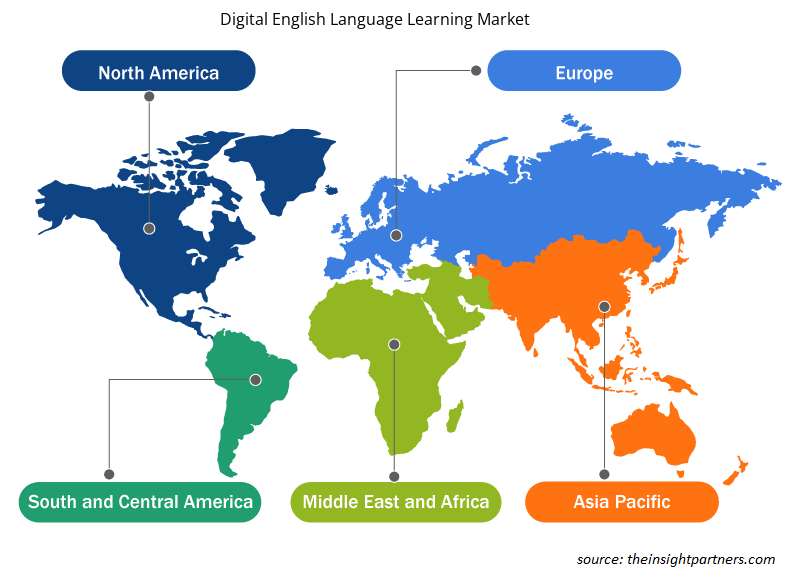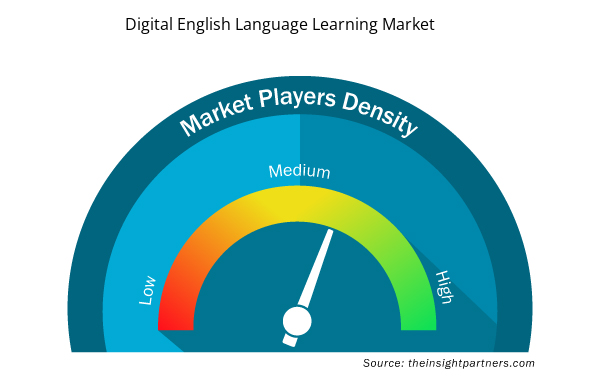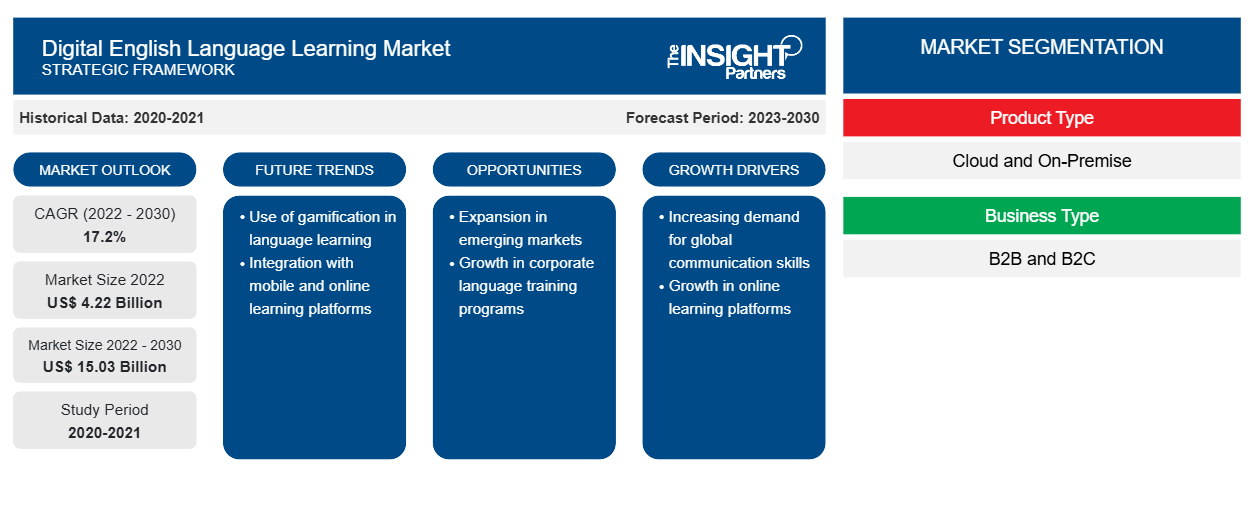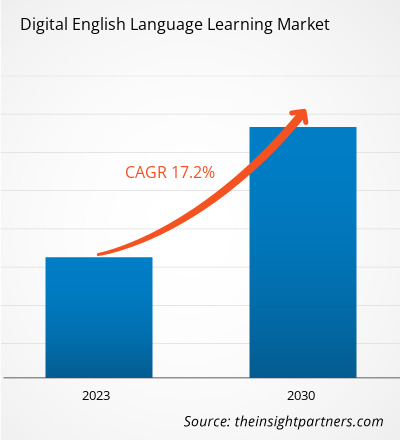[研究报告] 2022 年数字英语学习市场价值为 42.2 亿美元,预计到 2030 年将达到 150.3 亿美元;预计 2022 年至 2030 年的复合年增长率为 17.2%。
数字英语学习市场 的趋势包括虚拟现实和增强现实的使用日益增多。
分析师观点:
从商业角度来看,英语是全球最受欢迎的语言,近 30 个国家将英语作为其主要交流语言。因此,英语已被各行各业视为交流的通用语言。由于全球化的不断推进,业务不断扩展到世界各地,英语被视为一种强制性交流语言,这推动了数字英语学习市场的增长。数字英语学习包括数字内容和产品,可通过各种基于 ICT 的交互式工具促进轻松学习。各种交互式工具包括移动应用程序、电子书、音频剪辑、视频、游戏、数字软件和在线辅导。
数字英语学习市场竞争激烈且分散。随着该市场的领先公司通过多样化客户群、扩大现有产品组合以及开发新应用和市场来不断扩大其目标市场,所有主要参与者都面临着日益激烈的竞争,既有来自初创公司的竞争,也有来自全球领先的成熟公司的竞争。价值链中的几家公司收购或与市场上的其他参与者合并,以保持其地位并为客户提供有效的解决方案。
数字英语语言学习市场概览:
数字革命几乎改变了社会的方方面面。信息和通信技术 (ICT) 行业的巨大进步为包括教育在内的各个商业领域带来了范式转变。数字化对教育行业产生了深远的影响,该行业利用技术的力量简化学习过程,使学生能够互动。教育行业数字化的兴起推动了数字英语学习市场的增长,因为数字英语学习平台以创新和互动的方式帮助学生提高英语水平。
随着人工智能(AI) 在技术领域的渗透率不断提高 ,英语学习行业预计将发生重大变化。将人工智能融入英语学习工具中,可以根据从多个来源收集的数据提供定制的语言学习解决方案。许多其他工具也正在投入研发,然后投入商业使用,以使英语学习更容易、更具互动性,从而导致采用数字英语学习平台来学习英语。因此,使用人工智能技术学习英语可能会在未来几年对数字英语学习市场规模产生重大影响。
定制此报告以满足您的需求
您可以免费定制任何报告,包括本报告的部分内容、国家级分析、Excel 数据包,以及为初创企业和大学提供优惠和折扣
- 获取此报告的关键市场趋势。这个免费样品将包括数据分析,从市场趋势到估计和预测。
数字英语语言学习市场驱动因素:
教育领域数字化的兴起推动了数字英语学习市场的增长
在 21 世纪,技术正在接管每个行业。发展中国家的教育行业是数字化发展迅速的行业之一。中国、印度和巴西等发展中国家对数字化教育的需求很高。中国、韩国和澳大利亚的学校旨在让学生做好准备,以适应快速变化的数字化世界。教育行业的数字化是推动中国、日本和阿联酋等非英语国家英语学习的关键因素。印度是教育行业数字化蓬勃发展的顶级国家之一,预计未来几年将形成一个巨大的市场。
数字化学习涉及多种技术,可提高学生学习、口语和写作英语以及学习其他科目的能力。一些技术包括在线课程、数字教科书、在线考试和动画。数字化教育使世界各国的教育部门实现了现代化,其他一些发展中国家也越来越多地采用数字化教育,以使学生达到西方国家学生的标准。此外,各种公司都在推出英语学习平台。例如,iCourse International 于 2020 年 4 月 28 日由中国高等教育出版社正式推出。英语是该平台的主要语言,还有其他语言版本。同样,学堂在线于 2020 年 4 月发布了 MOOCs 平台的国际版本,以及首批 109 门英语在线课程。
中国、印度、巴西和阿联酋等国家的学生对在线英语语法课程的需求不断增加,学校、大学和教育机构采用的现代技术促进了数字英语学习市场的增长。
数字英语语言学习市场细分分析:
数字英语学习市场根据产品类型、业务类型和最终用户进行细分。根据产品类型,市场分为云和本地。根据业务类型,市场分为 B2B 和 B2C。根据最终用户,市场分为非学术学习者和学术学习者。
2022 年,云部分占据了更大的数字英语学习市场份额,预计在预测期内将录得更高的复合年增长率。基于云的数字英语学习是指在线课程。由于互联网在全球范围内的普及率不断提高,提供在线学习材料以提高英语学习能力的公司正在受益。这些在线平台使学生能够从课程中学习,还方便学生进行在线考试,以根据自己的能力评估自己。电子书和在线学习材料越来越受欢迎,因为它们允许学生从不同的网络内容中学习。此外,在线网络研讨会、在线辅导和在线课程为学生提供即时提示和反馈,提高他们的英语学习能力。
互联网普及率的大幅提升推动了云端数字英语学习市场的扩张。此外,智能手机和平板电脑的使用也让学生可以在任何地方学习,提高英语口语和写作能力。
数字英语语言学习市场区域分析:
数字英语学习市场报告的范围涵盖北美、欧洲、亚太地区、中东和非洲以及南美和中美洲。就收入而言,亚太地区在 2022 年占据了市场份额的主导地位。
亚太地区包括中国、印度、澳大利亚、新加坡和韩国等国家。这些国家的教育水平较高。他们正在使用一切可能的方法和模式来提高英语水平,目的是增加英语使用者的数量。根据英孚教育的首届英语水平测试,在非英语母语人士中,亚洲仅次于欧洲,排名第二。多年来,亚太地区各国一直在大力投资英语,为英语学习提供了丰厚的机会。
数字化转型是近年来对亚太地区教育行业产生重大影响的另一个因素。中国和澳大利亚是在大学和学校实施数字教育的最突出的国家。数字教育也提供英语学习。然而,韩国和中国在亚太地区数字英语学习市场份额中处于领先地位。印度在“数字印度”计划下实施了各种举措来增加数字教育。同样,DIKSHA 是印度的数字基础设施,用于为各年级的学校教育提供优质的电子内容(UnitTests)和二维码激活教科书。截至 2023 年 6 月,DIKSHA 已记录了超过 52.4 亿个学习课程、超过 612.5 亿个学习分钟和超过 2200 万个学习课程。这些举措正在帮助亚太地区的数字英语学习市场大幅增长。
数字英语语言学习市场区域洞察
Insight Partners 的分析师已详细解释了预测期内影响数字英语语言学习市场的区域趋势和因素。本节还讨论了北美、欧洲、亚太地区、中东和非洲以及南美和中美洲的数字英语语言学习市场细分和地理位置。

- 获取数字英语语言学习市场的区域特定数据
数字英语语言学习市场报告范围
| 报告属性 | 细节 |
|---|---|
| 2022 年市场规模 | 42.2亿美元 |
| 2030 年市场规模 | 150.3亿美元 |
| 全球复合年增长率(2022 - 2030 年) | 17.2% |
| 史料 | 2020-2021 |
| 预测期 | 2023-2030 |
| 涵盖的领域 | 按产品类型
|
| 覆盖地区和国家 | 北美
|
| 市场领导者和主要公司简介 |
|
市场参与者密度:了解其对商业动态的影响
数字英语语言学习市场正在快速增长,这得益于终端用户需求的不断增长,而这些需求又源于消费者偏好的不断变化、技术进步以及对产品优势的认识不断提高等因素。随着需求的增加,企业正在扩大其产品范围,进行创新以满足消费者的需求,并利用新兴趋势,从而进一步推动市场增长。
市场参与者密度是指在特定市场或行业内运营的企业或公司的分布情况。它表明在给定市场空间中,相对于其规模或总市场价值,有多少竞争对手(市场参与者)存在。
在数字英语语言学习市场运营的主要公司有:
- 英孚教育
- ELSA 公司
- 霍顿·米夫林·哈考特公司
- 麦克米伦
- 麦格劳·希尔教育集团
免责声明:上面列出的公司没有按照任何特定顺序排列。

- 了解数字英语语言学习市场顶级关键参与者概况
关键球员分析:
数字英语语言学习市场分析基于 EF Education First、ELSA Corp.、Houghton Mifflin Harcourt Co、MACMILLAN、牛津大学出版社、Pearson Plc、Sanako Corporation、Babbel GmbH、Transparent Language、Vipkid、剑桥大学出版社、Voxy、Chegg Inc、Duolingo Inc、INLINGUA INTERNATIONAL LTD.、Berlitz Corporation 和 IXL Learning 等主要参与者的年度表现。还分析了其他几个关键市场参与者,以全面了解市场及其生态系统。
最新动态:
数字英语学习市场报告强调了推动市场发展的关键因素和知名参与者的发展。市场参与者专注于无机和有机战略以实现业务增长。根据公司新闻稿,以下是一些最近的关键发展:
- 2023 年 7 月,Berlitz 向微软求助,特别是 Azure AI Speech 及其发音评估功能。借助这项技术,Berlitz 可以提供最快、最有效的学习新语言的方法,同时还增加了灵活性,使 Berlitz 能够接触到更多的学习者。
- 2021年3月,个性化学习产品开发商IXL Learning收购了基于技术的语言教育平台Rosetta Stone。
- 历史分析(2 年)、基准年、预测(7 年)及复合年增长率
- PEST 和 SWOT 分析
- 市场规模价值/数量 - 全球、区域、国家
- 行业和竞争格局
- Excel 数据集


- Social Employee Recognition System Market
- Precast Concrete Market
- Adaptive Traffic Control System Market
- Bio-Based Ethylene Market
- Portable Power Station Market
- Industrial Valves Market
- Electronic Toll Collection System Market
- Adaptive Traffic Control System Market
- Battery Testing Equipment Market
- Microcatheters Market

Report Coverage
Revenue forecast, Company Analysis, Industry landscape, Growth factors, and Trends

Segment Covered
This text is related
to segments covered.

Regional Scope
North America, Europe, Asia Pacific, Middle East & Africa, South & Central America

Country Scope
This text is related
to country scope.
常见问题
The incremental growth expected to be recorded for the global digital English language learning market during the forecast period is US$ 10.81 billion.
The global digital English language learning market is expected to reach US$ 15036.40 million by 2030.
The key players holding majority shares in the global digital English language learning market are Oxford University Press, Cambridge University Press & Assessment, Houghton Mifflin Harcourt, Chegg Inc., and Cengage Learning, Inc.
Increasing use of virtual reality and augmented reality which is anticipated to play a significant role in the global digital English language learning market in the coming years.
Increasing number of candidates from Asian countries registering for competitive exams for foreign countries, rising digitalization in educational sector, and increasing gamification of language learning platforms are the major factors that propel the global digital English language learning market.
The global digital English language learning market was estimated to be US$ 4.22 billion in 2022 and is expected to grow at a CAGR of 17.2 % % during the forecast period 2023 - 2030.
Trends and growth analysis reports related to Technology, Media and Telecommunications : READ MORE..
The List of Companies - Digital English Language Learning Market
- EF EDUCATION FIRST
- ELSA, Corp.
- Houghton Mifflin Harcourt Co
- MACMILLAN
- McGraw-Hill Education Inc
- OXFORD UNIVERSITY PRESS
- Pearson Plc
- ROSETTA STONE INC.
- Sanako Corporation
- Babbel GmbH
The Insight Partners performs research in 4 major stages: Data Collection & Secondary Research, Primary Research, Data Analysis and Data Triangulation & Final Review.
- Data Collection and Secondary Research:
As a market research and consulting firm operating from a decade, we have published and advised several client across the globe. First step for any study will start with an assessment of currently available data and insights from existing reports. Further, historical and current market information is collected from Investor Presentations, Annual Reports, SEC Filings, etc., and other information related to company’s performance and market positioning are gathered from Paid Databases (Factiva, Hoovers, and Reuters) and various other publications available in public domain.
Several associations trade associates, technical forums, institutes, societies and organization are accessed to gain technical as well as market related insights through their publications such as research papers, blogs and press releases related to the studies are referred to get cues about the market. Further, white papers, journals, magazines, and other news articles published in last 3 years are scrutinized and analyzed to understand the current market trends.
- Primary Research:
The primarily interview analysis comprise of data obtained from industry participants interview and answers to survey questions gathered by in-house primary team.
For primary research, interviews are conducted with industry experts/CEOs/Marketing Managers/VPs/Subject Matter Experts from both demand and supply side to get a 360-degree view of the market. The primary team conducts several interviews based on the complexity of the markets to understand the various market trends and dynamics which makes research more credible and precise.
A typical research interview fulfils the following functions:
- Provides first-hand information on the market size, market trends, growth trends, competitive landscape, and outlook
- Validates and strengthens in-house secondary research findings
- Develops the analysis team’s expertise and market understanding
Primary research involves email interactions and telephone interviews for each market, category, segment, and sub-segment across geographies. The participants who typically take part in such a process include, but are not limited to:
- Industry participants: VPs, business development managers, market intelligence managers and national sales managers
- Outside experts: Valuation experts, research analysts and key opinion leaders specializing in the electronics and semiconductor industry.
Below is the breakup of our primary respondents by company, designation, and region:

Once we receive the confirmation from primary research sources or primary respondents, we finalize the base year market estimation and forecast the data as per the macroeconomic and microeconomic factors assessed during data collection.
- Data Analysis:
Once data is validated through both secondary as well as primary respondents, we finalize the market estimations by hypothesis formulation and factor analysis at regional and country level.
- Macro-Economic Factor Analysis:
We analyse macroeconomic indicators such the gross domestic product (GDP), increase in the demand for goods and services across industries, technological advancement, regional economic growth, governmental policies, the influence of COVID-19, PEST analysis, and other aspects. This analysis aids in setting benchmarks for various nations/regions and approximating market splits. Additionally, the general trend of the aforementioned components aid in determining the market's development possibilities.
- Country Level Data:
Various factors that are especially aligned to the country are taken into account to determine the market size for a certain area and country, including the presence of vendors, such as headquarters and offices, the country's GDP, demand patterns, and industry growth. To comprehend the market dynamics for the nation, a number of growth variables, inhibitors, application areas, and current market trends are researched. The aforementioned elements aid in determining the country's overall market's growth potential.
- Company Profile:
The “Table of Contents” is formulated by listing and analyzing more than 25 - 30 companies operating in the market ecosystem across geographies. However, we profile only 10 companies as a standard practice in our syndicate reports. These 10 companies comprise leading, emerging, and regional players. Nonetheless, our analysis is not restricted to the 10 listed companies, we also analyze other companies present in the market to develop a holistic view and understand the prevailing trends. The “Company Profiles” section in the report covers key facts, business description, products & services, financial information, SWOT analysis, and key developments. The financial information presented is extracted from the annual reports and official documents of the publicly listed companies. Upon collecting the information for the sections of respective companies, we verify them via various primary sources and then compile the data in respective company profiles. The company level information helps us in deriving the base number as well as in forecasting the market size.
- Developing Base Number:
Aggregation of sales statistics (2020-2022) and macro-economic factor, and other secondary and primary research insights are utilized to arrive at base number and related market shares for 2022. The data gaps are identified in this step and relevant market data is analyzed, collected from paid primary interviews or databases. On finalizing the base year market size, forecasts are developed on the basis of macro-economic, industry and market growth factors and company level analysis.
- Data Triangulation and Final Review:
The market findings and base year market size calculations are validated from supply as well as demand side. Demand side validations are based on macro-economic factor analysis and benchmarks for respective regions and countries. In case of supply side validations, revenues of major companies are estimated (in case not available) based on industry benchmark, approximate number of employees, product portfolio, and primary interviews revenues are gathered. Further revenue from target product/service segment is assessed to avoid overshooting of market statistics. In case of heavy deviations between supply and demand side values, all thes steps are repeated to achieve synchronization.
We follow an iterative model, wherein we share our research findings with Subject Matter Experts (SME’s) and Key Opinion Leaders (KOLs) until consensus view of the market is not formulated – this model negates any drastic deviation in the opinions of experts. Only validated and universally acceptable research findings are quoted in our reports.
We have important check points that we use to validate our research findings – which we call – data triangulation, where we validate the information, we generate from secondary sources with primary interviews and then we re-validate with our internal data bases and Subject matter experts. This comprehensive model enables us to deliver high quality, reliable data in shortest possible time.


 获取此报告的免费样本
获取此报告的免费样本